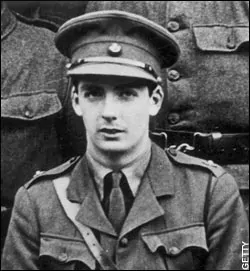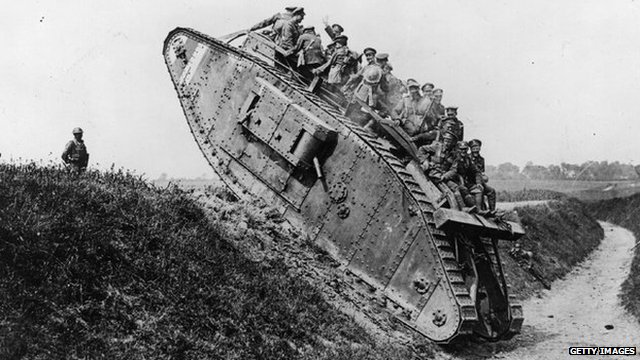The Arrival of the Tank; German Infantry Terrified.
A Future British Prime Minister Witnesses the Monster.
Special to The Great War Project.
(13-17 September) On this date, September 15th, precisely a century ago, a new weapon appeared at the battle of the Somme – the tank.
The first tanks belonged to the Allies. They fielded forty-nine tanks “moving forward on a wide front,” reports historian Martin Gilbert. “Ten of the tanks were quickly hit by German artillery fire.” After all, it is a slow moving easy target.

British troops pose with new tank in the Battle of the Somme.
“Nine of the tanks broke down with mechanical difficulties,” Gilbert writes, “and five failed to advance. But those that did manage to go forward were able to advance more than 2,000 yards.” They capture several small villages.
Both Winston Churchill, who is no longer in a position of power, and Field Marshall Douglas Haig, who still is, recognize the value and great potential of these “land battleships” as Churchill calls them.
Churchill expresses frustration that the tanks are used only on a petty scale. But Haig immediately grasps their value. Reports Gilbert “Recognizing the potential of the new weapon, Haig asked the War Office for a thousand of them.”
“The Germans were far behind in their tank experiments.”
Some historians believe the introduction of the tank marks a significant change in the battle. “The offensive at the Somme,” writes war historian John Keegan, “might have been doomed to drift away into an autumn of frustration and a winter of stalemate had it not been for the appearance” of the tank, a weapon that is armored against bullets and that “could bring fire power to the point of assault.”

Some of the tanks were quickly disabled.
The new vehicles are equipped with external guns, and caterpillar tracks. They permit it to maneuver across uneven terrain that wheeled vehicles cannot navigate.
“The appearance of the tanks terrified the German infantry defending their sectors,” reports Keegan, “and the armored monsters led the British onward for 3500 yards before mechanical breakdowns and ditchings in rough ground brought the advance to a halt.”
“A number caught in artillery fire were knocked out,” observes Keegan. “The event brought one of the cheapest and most spectacular local victories of the war on the Western Front thus far.”
“But its efforts were to be frustrated immediately by the disablement of almost all the thirty-six tanks that had crossed the start line.”

The young British officer Harold MacMillan.
One of the soldiers who witnesses the arrival of the new weapon is Harold MacMillan, the future British prime minister. “MacMillan was badly wounded on September 15th”, writes historian Gilbert. “He survived throughout the morning in No-Man’s Land, in a shell-hole which was twice blown in on top of him by German shells exploding a few yards off.”
“Making his own way back after a while to the field hospital MacMillan was caught by a sudden and severe bout of shelling.”
“Then I was very frightened,” he writes later. MacMillan does reach a field hospital, with bullet fragments. Surgeons who treat him conclude it will be too dangerous to try to remove these fragments from his pelvis. “This gave him for the rest of his life a shuffling walk. He remained on crutches with a tube in the wound until the end of the war.”
Gilbert reports: “MacMillan remembers during the day on which he was wounded he recalled seeing a tank, one of these strange objects bogged down in a shell-hole.
...The ungainly vehicle was quickly to prove its worth even when used in small numbers.”

The tank as troop carrier, battle of the Somme, autumn 1916.
Within days a British attack supported by just two tanks seized several villages on the Somme. Five hundred Germans are taken prisoner with only five British casualties.
By the way, ‘tank’ is a code-name used by the British to hide the special project they were working on to develop the new weapon.
